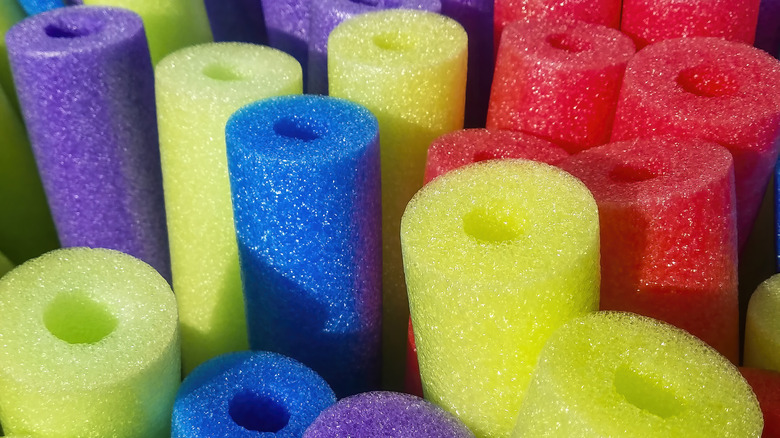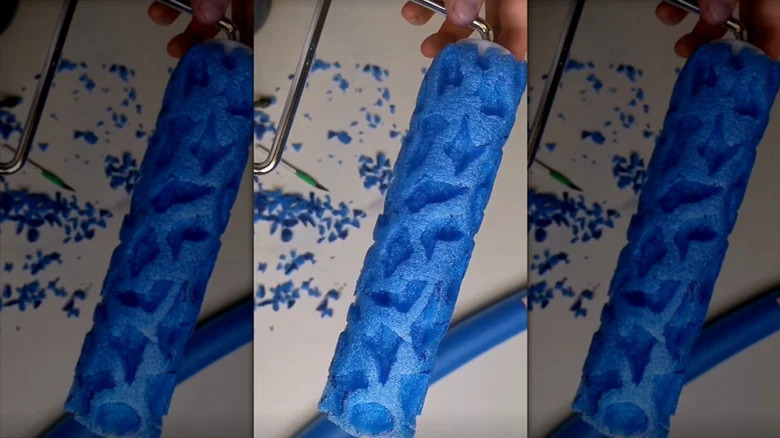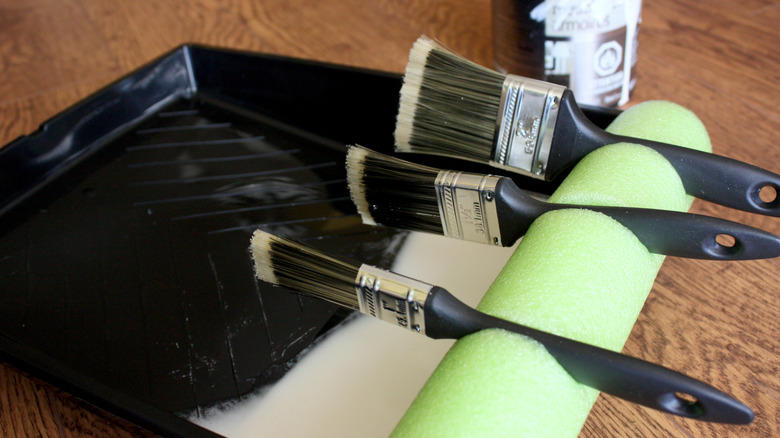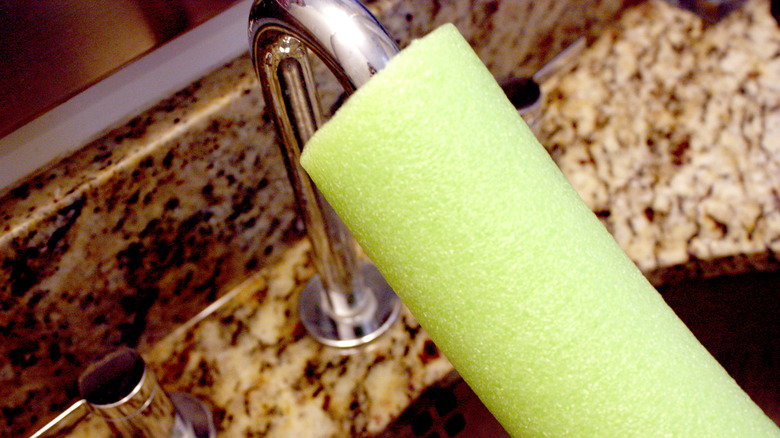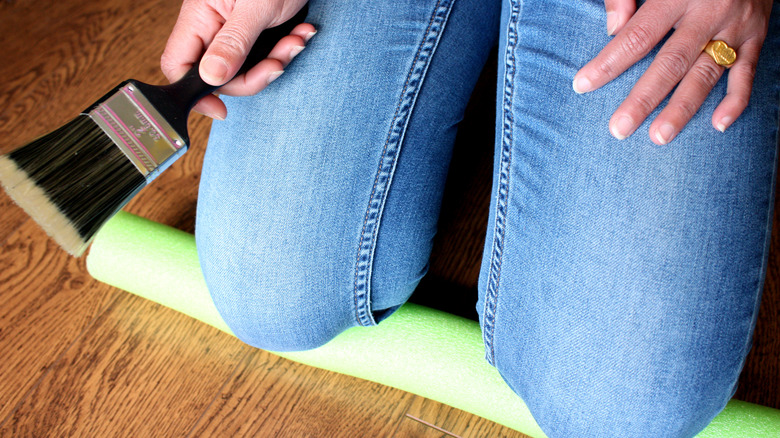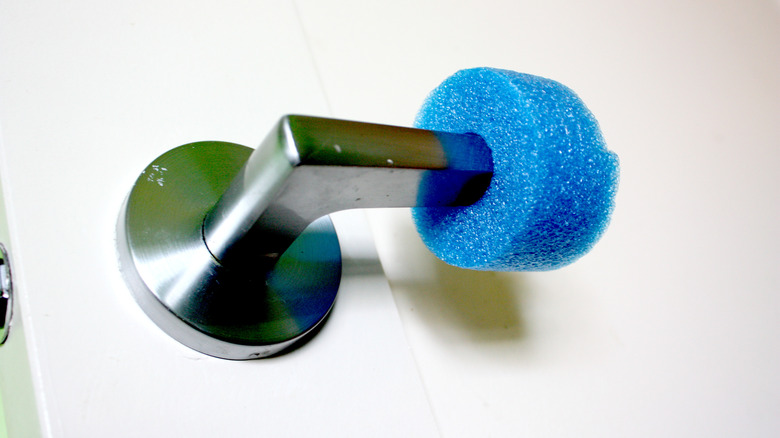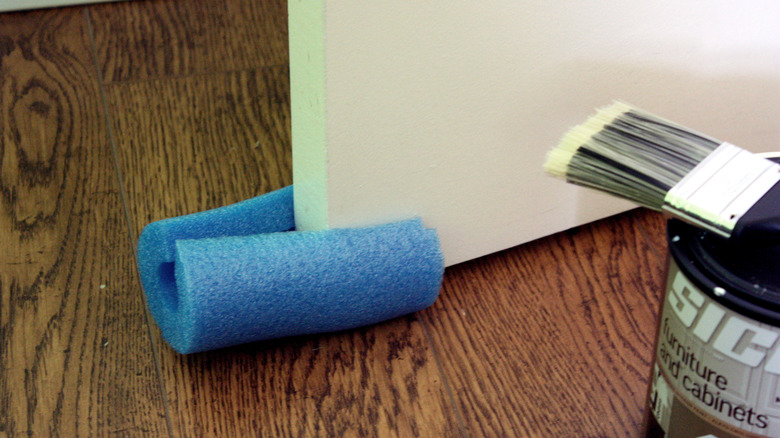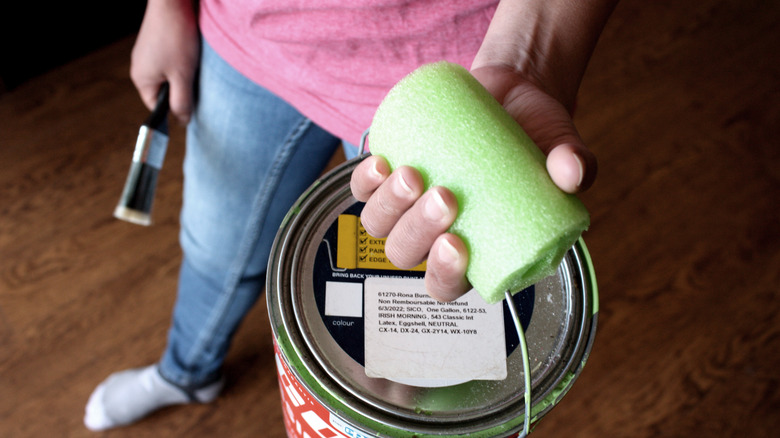Clever Pool Noodle Hacks To Help With Your Next Painting Project
Are you starting a painting project? Before you head off to the hardware store in search of supplies, see if you have a pool noodle kicking around at home. This ubiquitous children's toy is a surprisingly helpful (and inexpensive) painting partner that handily morphs into various accessories with a few cuts of a knife. Thanks to its elastic, firm, yet lightweight composition, you can fashion a pool noodle into a paintbrush holder, a wet surface marker, and more.
Below we've rounded up some of the most practical and valuable pool noodle uses on a painting job. To equip you with helpful instructions for transforming and using these toys into functional accessories, we've tested several of these hacks ourselves. Fortunately, you don't need much skill or any specialized equipment to employ these clever hacks. As long as you have a serrated or utility knife, it won't take you much effort to alter a pool noodle into a convenient painting tool.
Use a pool noodle to hang cabinet doors for painting
Bits of pool noodle can help you paint cabinet doors by keeping them separated while they are hung to paint. Hanging cabinet doors is a clever way to paint and dry them because by doing so you minimize their contact area with other surfaces. All you need is two cup hooks placed at the bottom of each door, some clothes hangers, and a clothing rack or bar to suspend the doors above the floor. But, how do you keep the doors from contacting one another? This is where the humble pool noodle becomes your helpful painting partner.
Here's how you can set up your drying spot quickly and with little mess. First, you'll need to hang the doors before painting them. Start by inserting two cup hooks into the bottom of each door, with one hook on each side of the edge to ensure balance when hanging. You can either drill a pilot hole or screw the hooks in by hand. Next, hook the first door you're painting onto a hanger, then suspend the hanger from the clothing rack. You can now paint or stain the door. When you're done painting the first door, cut a 6- to 8-inch pool noodle section, and make a horizontal incision in it such that the tube opens up slightly. Slide the noodle onto the rack. You should position the noodle section right next to the coat hanger holding the first door — it will serve as a buffer when you hang the rest of the doors. That's it! Now, just repeat the same steps for the rest of your doors and wait for them to dry. The pool noodle will keep them safely apart.
Give your wall some character with a textured accent
You can use a pool noodle as a roller to paint unique patterns on your wall following this tutorial from @Interior_Works on YouTube. Normally, customizing your wall with one-of-a-kind design requires intricate brushwork. This type of work takes time and can get a bit tedious if you're covering large areas. Moreover, you will struggle to draw a consistent pattern without using some sort of stencil. On the other hand, a skillfully altered pool noodle placed on a roller can help you paint personalized imprints on any surface with minimal effort. Best of all, you can give your makeshift paint stamper virtually any design you like.
To turn your pool noodle into a custom stamper, start by cutting a piece of the noodle to fit the roller. Measure the length of your paint roller cage, then cut a piece of the pool noodle to that dimension. A utility knife, saw, or any blade with a serrated edge are all effective tools for cutting pool noodles. Once you have a suitably sized pool noodle piece, go ahead and engrave it with your preferred pattern. A utility knife works well for this purpose. You can cut geometric shapes or try your hand at something more naturalistic like leaves. Since a pool noodle yields more than a single roller-sized piece, go ahead and cut several to give them all distinct patterns — you can overlap these on your wall for a more striking and original accent. As an alternative to engraving the foam, you can also wrap your pool noodle in bubble wrap, canvas, or even a plastic bag to get a wider selection of patterns. With the noodle engraved (or wrapped), you can use it as you would use a regular paint roller.
Keep your paint brushes secure with a pool noodle holder
You can turn your pool noodle into a sturdy, convenient brush holder for your next painting job. Most painting projects require multiple tools for paint applications. You'll use a flat brush for the larger surfaces, an angular one for tricky corners, and a foam brush for intricate trim. But when you're using several brushes at the same time, you run into the problem of keeping them handy and away from other items. The last thing you want is for your paint brushes to fall on the floor, or to accidentally get paint marks where you don't want them. Once again, your pool noodle affords a quick solution to the potential mess by serving as a DIY brush holder.
To fashion your pool noodle into a brush holder, first cut off a segment that matches the length of the edge of your paint tray. Next, make a cut spanning the length of the noodle segment. This opening will let you clip your new brush holder onto the tray's edge. Finally, make several perpendicular incisions in the foam to accommodate the brushes. You can easily fit between five and seven brushes along the short edge of a paint tray, but the number of perpendicular cuts is up to you. Note that you're not limited to using this DIY holder with a tray. It can also fit buckets, tubs, and wide-mouth jars.
Use a pool noodle as a hose when washing your painting tray or bucket
A pool noodle can function as an improvised water hose when it's time to clean up after your painting job, following a hack from @alifebetterorganized on YouTube. If you need to soak your brushes or rinse your paint tray at the end of the day, you'll need access to water. This may be tricky if you don't have a utility room with a service sink and don't want to get paint all over your kitchen or bathroom sinks. Likewise, smaller household sinks may be too small to fit larger buckets or trays. In these situations, if you don't have a water hose, you'll have a hard time getting water to these containers. Luckily, a pool noodle can serve as a water hose and let you deliver water easily from your faucet to the container of your choice. Since pool noodles are made of polyethylene foam, they're water resistant, so you don't need to worry about any leaks while the water flows through them.
To use a pool noodle as a hose, start by slipping one end of it over the faucet. Then, place the other end into the container you want to fill, such as a bucket for soaking brushes. Holding the end at the faucet, turn the water on, then control the direction of the flow with your free hand. Since pool noodles are not water-proof (only water resistant) don't make them a permanent replacement for hoses or pipes.
Create a simple, inexpensive knee pad for painting
You can use a pool noodle as a knee pad while painting. Painting jobs and touch-ups often involve surfaces close to the floor, such as baseboards. Painting these requires you to kneel — a very uncomfortable position that's also dangerous without proper protection. Frequent kneeling stresses the knee and can injure the joint. Using knee pads mitigates this risk. If you didn't foresee needing a knee pad for your painting job, you may be tempted to skip a hardware store trip and work without the right protection. But, if you have a pool noodle at home, you can quickly fashion an effective barrier between your knees and the hard floor surface. Better yet, this DIY knee pad will cost you less than $1.
Making a knee pad out of a pool noodle is really a no-brainer. Just cut a piece of the noodle long enough to accommodate both your knees. To get the length right, use measuring tape to check the distance between your knees when you're kneeling down. Try changing your positions several times the way you would if you were painting, and measure the longest distance between the outer edges of your knees. This is how long your makeshift knee pad should be!
Identify freshly painted doors and drawers with pool noodle rings
Pool noodles come in handy when you want to mark freshly painted doors or drawers. If you're painting doors in your house, it's a good idea to identify those with a new coat of paint on them. Labeling painted surfaces helps keep your family members from getting their clothes dirty and also helps you track what you've painted. Pool noodles serve as fantastic markers in this situation because their bright colors are highly conspicuous and their circular shape fits door and drawer handles seamlessly. Pool noodles are also inexpensive, so you don't have to worry too much about the costs of cutting one up for your painting project.
To create wet paint markers out of a pool noodle, cut it into narrow, one-inch bits. If you're painting doors with lever-style handles, no further cuts are required — the little colorful circles should fit on these handles without issues. However, if your doors have knobs, the noodle's hole will be too small to accommodate them. In this case, make a perpendicular cut in the little circle — this new opening will fit in the spot between the knob and the rosette. The same trick will let you hang pool noodle markers on bar-style drawer handles. If your project involves more than a single coat of paint, you can use two differently colored pool noodles to make the markers. One color will signify the first coat, and another will mean that the second coat has gone on.
Use a pool noodle as a door stopper while painting
You can use a pool noodle to stabilize the door you're painting. Few things are as annoying as a door leaf that's constantly moving while you're giving it a coat of paint. If you don't have door stoppers at home, you've probably tried jamming folded cardboard between the panel and the floor and know what a flimsy solution that is. Pool noodles are much better at the task. Their flexible nature lets you squeeze them under the door (or between the leaf and the side jamb) without a struggle. Meanwhile, their polyethylene composition provides plenty of grip to keep the door immobilized while you paint. And, since polyethylene is resilient to wear, you should be able to reuse your pool noodle door stopper several times before it loses its form and utility.
To make a DIY door stopper out of a pool noodle, cut off a 4-to-6-inch piece. To use it beneath the door, you'll have to make a cut parallel to the length of the noodle to create a flatter foam surface. Conversely, if inserting the foam between the leaf and the side jam, you should be able to use the cylinder as is, without cutting it open lengthwise. Just note that sticking a pool noodle in the opening between the door and the jamb will hold the leaf in the fully open position away from the door frame. This method still lets you move the leaf back and forth a bit, whereas placing the foam under the panel immobilizes the door completely.
Make heavy paint bucket handles more comfortable
A pool noodle can work as an ergonomic, DIY foam grip that alleviates the discomfort of holding paint buckets by their wire handles. The wire handles most paint buckets come with are not very comfortable to carry. You can even find the experience painful if you're carrying heavy buckets for long distances, like up a flight of stairs or from your truck to the house. To make this task easier on your hands, use a piece of pool noodle as a comfy, improvised handle grip.
Fashioning a handle grip out of a pool noodle is a one-minute task. Start by cutting a piece long enough to fit the width of your palm. Then, make a lengthwise incision in the resulting cylinder and slide it over the paint bucket wire handle with the cut facing up. The foam should be sturdy enough for prolonged service, so you should be able to reuse this foam grip several times.
